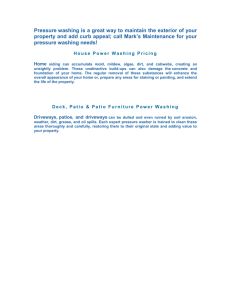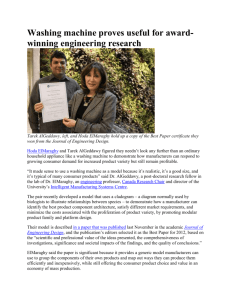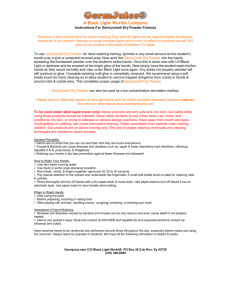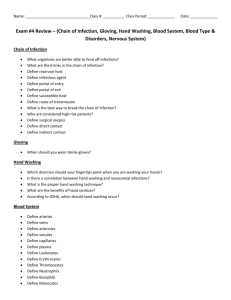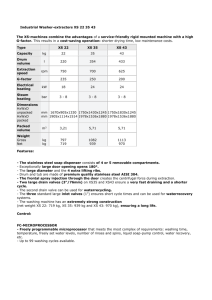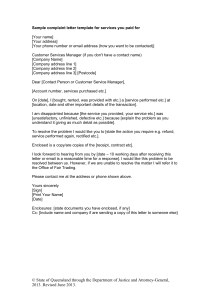PRACTICAL INVESTIGATION - Teaching Biology Project
advertisement
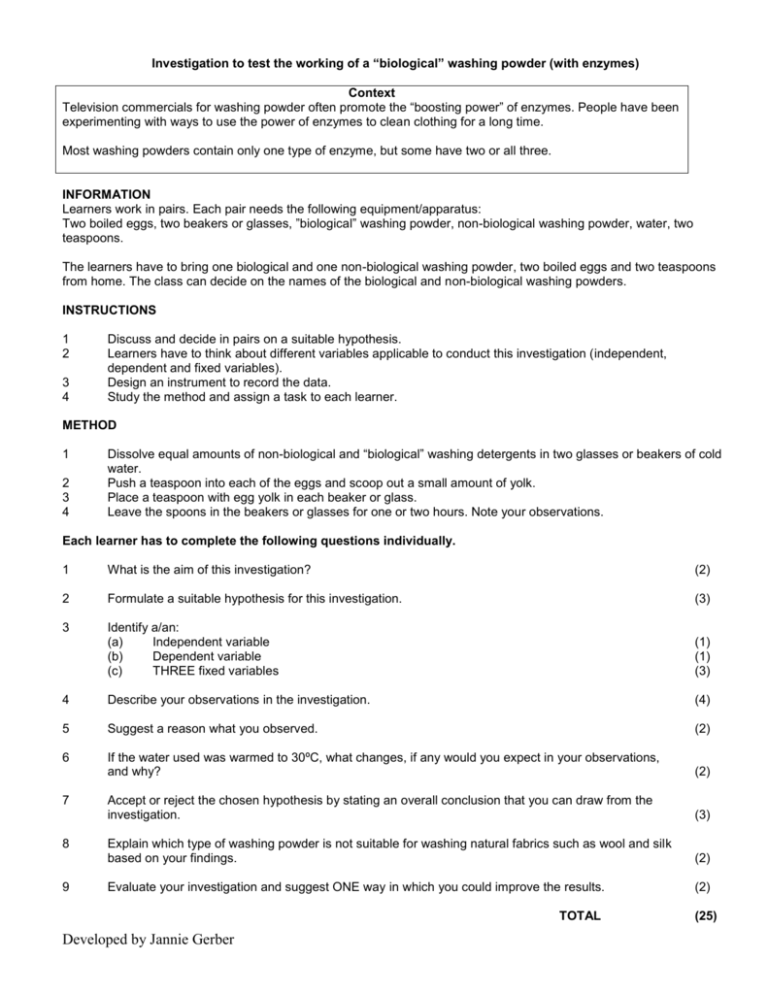
Investigation to test the working of a “biological” washing powder (with enzymes) Context Television commercials for washing powder often promote the “boosting power” of enzymes. People have been experimenting with ways to use the power of enzymes to clean clothing for a long time. Most washing powders contain only one type of enzyme, but some have two or all three. INFORMATION Learners work in pairs. Each pair needs the following equipment/apparatus: Two boiled eggs, two beakers or glasses, ”biological” washing powder, non-biological washing powder, water, two teaspoons. The learners have to bring one biological and one non-biological washing powder, two boiled eggs and two teaspoons from home. The class can decide on the names of the biological and non-biological washing powders. INSTRUCTIONS 1 2 3 4 Discuss and decide in pairs on a suitable hypothesis. Learners have to think about different variables applicable to conduct this investigation (independent, dependent and fixed variables). Design an instrument to record the data. Study the method and assign a task to each learner. METHOD 1 2 3 4 Dissolve equal amounts of non-biological and “biological” washing detergents in two glasses or beakers of cold water. Push a teaspoon into each of the eggs and scoop out a small amount of yolk. Place a teaspoon with egg yolk in each beaker or glass. Leave the spoons in the beakers or glasses for one or two hours. Note your observations. Each learner has to complete the following questions individually. 1 What is the aim of this investigation? (2) 2 Formulate a suitable hypothesis for this investigation. (3) 3 Identify a/an: (a) Independent variable (b) Dependent variable (c) THREE fixed variables (1) (1) (3) 4 Describe your observations in the investigation. (4) 5 Suggest a reason what you observed. (2) 6 If the water used was warmed to 30ºC, what changes, if any would you expect in your observations, and why? (2) Accept or reject the chosen hypothesis by stating an overall conclusion that you can draw from the investigation. (3) Explain which type of washing powder is not suitable for washing natural fabrics such as wool and silk based on your findings. (2) Evaluate your investigation and suggest ONE way in which you could improve the results. (2) 7 8 9 TOTAL Developed by Jannie Gerber (25) 2 Possible answers 1 To investigate the effect of washing powders (biological and non-biological) on egg yolk √√ (2) 2 Biological washing powders contain enzymes√ that can digest or break down the protein in egg yolk√ that ordinary washing powder cannot√ (3) 3 Independent variable – different washing powders√ Dependent variable – presence or absence of egg yolk on the teaspoons √ Fixed variables: Same amount of water, washing powder, egg yolk Same temperature in both glass beakers Same type of biological and non-biological washing powders Duration of teaspoons in glass beakers √√√ (1) (1) (3) Learners should observe that the spoon in the ordinary washing powder√ still has egg yolk on it √ There is less or no egg yolk√ on the spoon in the biological washing powder√ (4) The yolk on the spoon in the biological washing powder has been digested√ by the enzymes in the washing powder.√ (2) 6 The egg yolk would break down faster √ because the enzymes work faster at higher temperatures√ (2) 7 Hypothesis – accepted or rejected.√ Biological washing powders contain enzymes√ that can digest or break down proteins√ (3) Wool and silk are made mainly of protein √ and biological washing powders would digest the protein and destroy or damage the fabrics√ ﴾2﴿ Repeat the experiment / investigation a number of times√√ (2) 4 5 8 9 TATOT Developed by Jannie Gerber ﴾25﴿
